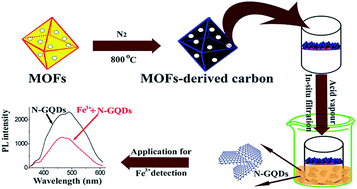Fabrication of a nitrogen-doped graphene quantum dot from MOF-derived porous carbon and its application for highly selective fluorescence detection of Fe3+†
Abstract
Nitrogen doping of carbon quantum dots results in improved fluorescence performance and a wider range of applications in photocatalysis, sensors, bioimaging, etc. Herein, a water-soluble and well-crystallized nitrogen-doped graphene quantum dot (N-GQD) has been obtained by using a MOF-derived carbon (ZIF-8C) as a new source of graphitic sheets. The preparation is based on a rapid, eco-friendly and efficient acid vapour cutting strategy, which is different from previously reported solution chemistry routes. The as-prepared N-GQD is photoluminescent and exhibits an excitation-independent behaviour. Because of the presence of O-functional groups on the surface, the obtained N-GQD can serve as a fluorescent sensing probe for highly selective detection of Fe3+ ions with a detection limit of 0.08 μM (at a signal-to-noise ratio of 3). This work would enable new opportunities for the wider use of MOF-based materials and also contribute to the fluorescent analysis of Fe3+.

- This article is part of the themed collection: JMC C Top Picks collection: The many faces of carbon

 Please wait while we load your content...
Please wait while we load your content...